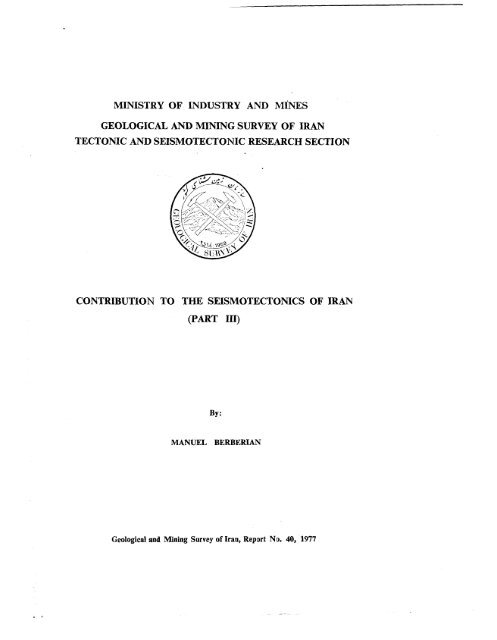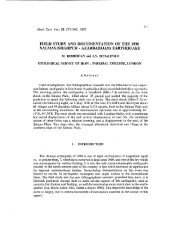PDF COPY - Manuel berberian
PDF COPY - Manuel berberian
PDF COPY - Manuel berberian
Create successful ePaper yourself
Turn your PDF publications into a flip-book with our unique Google optimized e-Paper software.
GEOLOGICAL AND MINING SURVEY OF IRAN, Report No. 40, 1977CONTENTSForeword, by R. Assefi, Managing Director, GMSI ..................... 3Preface, by M. Berberian, Head of Tectonic and Seismotectonic Research Section, GMSI. 5I. Khurgu (North Bandar Abbas:Iran) ~earthquake of March 21, 1977: A Preliminary FieldReport and a Seismotectonic Discussion. 38 Figures, 43 Pages.By: M. BERBERIAN, D. PAPASTAMATIOU and M. QORAISHI .......... 72. Naghan (Chahar Mahal Bakhtiari-High Zagros, Iran) earthquake of April 6, 1977:Preliminary Field Report and a Seismotectonic Discussion. 24 Figures, 27 Pages.By: M. BERBERIAN, and L NAVAI ............................ 513. Macroseismic Epicentres of Iranian Earthquakes. 21 Pages, 2 Tables.By: M. BERBERIAN ...................................... 794. Maximum Intensity, Isoseismal and Intensity Zone Maps of lran (4th century B. C.to 1977). 11 Figures, 15 Pages.By: M. BERBERIAN ...................................... 1015. Seismic Risk Map of Iran, a proposal. 21 Figures, 29 Pages.By: M. BERBERIAN and A. MOHAJER-ASHJAI .................... 1216. An Introduction to the Seismotectonics of Maku Region (NW Iran). 32 Figures 36 Pages.By: M. BERBERIAN ...................................... 1517. Against the Rigidity of the Lut Block; a Seismotectonic Discussion. 9 Figures, 24 Pages.By: M. BERBERIAN ...................................... 2038. The Shibli Rift System (Sahand Region, NW Iran). 6 Figures, 8 Pages,By: M. BERBERIAN and S. ARSHADI .......................... 2299. Three Phases of Metamorphism in Hajiabad Quadrangle (southeastern extremity ofthe Sanandaj-Sirjan structural zone): A Paleotectonic Discussion. 20 Figures, 22 Pages.By: M. BERBERIAN ..................................... 23910. Structural Analysis of Hamadan Metamorphic Tectonites: A Paleotectonic Discussion.9 Figures, 16 Pages.By: M. BERBERIAN and N. ALAVI-TEHRANI ..................... 263Abstracts in Farsi ........................................ 281
MAPSBy: M. Berberian, in pocket1. Historical Seismicity (pre 1900) Map of Iran, 1:5,000,000.2. Intensity Zone Map of Iran (4th century B.C. to 1900 A.D.), 1:5,000,00~3. Maximum Intensity of Earthquakes in Iran (1900-1977), 1:5,000,000.4, Isoseismal Map of Iran (1900-1977), 1:5,000,000.5. Intensity Zone Map of Iran (1900--1977), 1:5,000,0000.6. Intensity Zone Map of Iran (4th century B.C. to 1977 A.D.).7, Seismic Risk Map of Iran. a proposal, 1.5,000,0008. Structural Pattern of Hamadan Metamorphic Tectonites.
FOREWORDby Reza Assefi, Managing Director, Geological and Mining Survey of IranIn 1976, the Geological Survey of Iran published the first comprehensive studyof Iranian seismotectonics and earthquake faults. Based upon the researches of Mr.<strong>Manuel</strong> Berberian, our relevant expert in Tectonics and Seismotectonics, it wasentitled "Contributions to the Seismotectonics of Iran (Part II), and was publishedin commemoration of the fiftieth anniversary of the Pahlavi Dynasty.In that volume, full seismic data were given for the earthquakes which occurredin Iran from the 4th Century B.C. to March 1976, together with magnitude, focaldepth, and their relation to our present knowledge of faults and tectonic phenomena.For the first time, the Iranian faults were divided into various categories: three basedupon genetic classification, and three based upon recency of movement. The pertienentdata were presented on the accompanying "Seismotectonic Map of Iran".These reports and maps were received with enthusiasm by earth scientists workingon the many problems concerned with the seismotectonics of Iran. Design engineersinvolved in construction projects in Iran found the Seismotectonic Map both valuableand convenient for practical use. At the same time, however, they suggested that Mr.Berberian’s expertise might be further utilised to prepare a Seismic Risk Map of Iranon the basis of the earlier published volume, and more recent research.Acknowledging the justice of these observations, and the necessity of fulfillingthe engineer’s needs, the Geological and Mining Survey of Iran requested Mr. Berberianto prepare such a map as a matter of urgency. As with the previous volume, the timeavailable was limited, and Mr. Berberian devoted both his official working hours andhis spare time unstintingly to meet his deadline, whilst not allowing the high standardof his work to fall.On this Preliminary Seismic Risk Map of Iran, the country has been divided intofour different zones according to seismic risk. These zones will facilitate the builder’stask in choosing the correct anti-seismic code, and in selecting the most suitable constructionmaterials. The preparation of this Seismic Risk Map was the first step madeby the Geological and Mining Survey of Iran towards compiling a definitive versionat a future date. It is hoped that this step will encourage experts in the relevant fieldsto contribute such knowledge as they may have, for an accurate and completeSeismic Risk Map would be of inestimable value for the development of Iran.
Nature to be commanded, must be obeyed°(Francis Bacon)PREFACEIn the previously published research reports by the Tectonic and SeismotectonicResearch Section of the Geological Survey of Iran, we released some data and presentedthe results of research programmes on various aspects of the seismotectonics of Iran(Report No, 29, 1974, and Report No, 39. 1976).In the first contribution, which was presented by Tchalenko, Ambraseys andBerberian in 1974 under the title "Materials for the Study of Seismotectonics of Iran:North-Central Iran" (Geological Survey of Iran, Report No. 29, 1974, 158p.), datafor historical and 20th century seismicity of North-Central Iran were given. The tectonicframework of the Tehran region was emphasized, and a seismotectonic mapof North Central Iran was published with the volume.In the second contribution, which was presented by M. Berberian in 1976 underthe title "Contribution to the Seismotectonics of Iran:Part II" (Geological Surveyof Iran; Report No. 39, 1976, 518p., 5 Maps and 259 Figs.), the First SeismotectonicMap of Iran, the First Fault Map of Iran and three other maps were published togetherwith ten research reports on the seismotectonics of Iran. This volume facilitated thesolution of the basic problems of dividing the country into seismotectonic provincesand provoked further thought and research on the seismic risk map of the country.In the continuation of the same policy, the Tectonic and Seismotectonic ResearchSection of the Geological and Mining Survey of Iran prepared the present volume inorder to help those who are interested in the seismotectonics of Iran, with a view toencouraging exchange of information and comments. In this way, I hope that with thehelp of other scientists we can come to a better understanding of the seismotectonicsof Iran, and solve some of the remaining puzzles.I would like to thank Mr. R. Assefi, Managing Director, and Mr. J. Eftekhar-Nezhad, Deputy Managing Director, of the Geological Survey of Iran for constant encouragementand their understanding of the importance of seismotectonic investigation.I am grateful to my friends Mr. E. Burman, who prepared the report for publication,and Mr.A. Afaghi, whose group carried out the cartographic work for themaps of this volume.There is so much to discover,So little timeSuch a short life<strong>Manuel</strong> BerberianTectonic and Seismotectonic Research SectionGeological and Mining Survey of IranApril 1977, Tehran
tf,’







